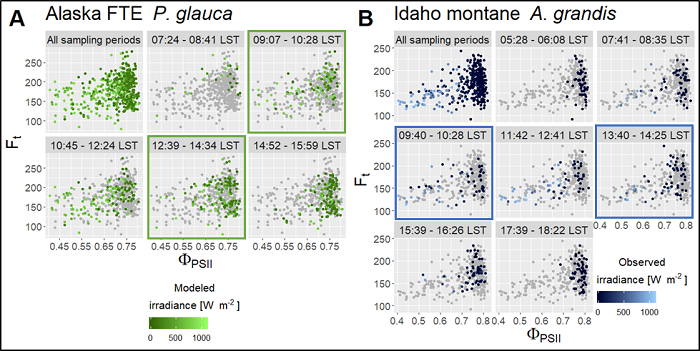ABoVE: Needle-Level Chlorophyll Fluorescence, Alaska and Idaho, USA, 2017 and 2019
This dataset from the NASA Arctic-Boreal Vulnerability Experiment (ABoVE) field campaign provides in situ measurements of needle-level chlorophyll fluorescence (ChlF) obtained from a pulse amplitude modulated (PAM) fluorometer from evergreen needleleaf forested sites in Alaska and Idaho. Measured light-adapted minimal fluorescence (Ft) is reported as the quantum yield of fluorescence and light-adapted variable fluorescence over maximal fluorescence (Fv/Fm) and is reported as the quantum yield of photosystem II. Also reported are two modeled irradiance products: (1) the top-of-canopy instantaneous irradiance (W/m2) and (2) needle-level irradiance (W/m2). Both products were modeled to be contemporaneous with ChlF observations. At the Alaska site, located in the northern latitudinal forest-tundra ecotone near the Dalton Highway, 36 Picea glauca (white spruce) trees were sampled on 2017-07-07 to 2017-07-08. The Idaho field site is located in a montane forest near McCall, where 10 Abies grandis (grand fir) trees were sampled on 2019-07-05 to 2019-07-06. Measurement of needle-level ChlF occurred during clear-sky conditions such that the canopies experienced a broad range of variability in sunlit-shading patterns across the day during these near-solstice periods.
The ABoVE field campaign is being conducted in Alaska and western Canada, for 8 to 10 years, starting in 2015. Research for ABoVE links field-based, process-level studies with geospatial data products derived from airborne and satellite sensors, providing a foundation for improving the analysis, and modeling capabilities needed to understand and predict ecosystem responses to, and societal implications of, climate change in the Arctic and Boreal regions.
Additional data from the ABoVE Field Campaign and other relevant links can be found on the ORNL DAAC's ABoVE project page.
Data Citation: Maguire, A.J., J. Eitel, K. Griffin, S.C. Schmiege, S.G. Bruner, N. Boelman, and W. Weygint. 2020. ABoVE: Needle-Level Chlorophyll Fluorescence, Alaska and Idaho, USA, 2017 and 2019. ORNL DAAC, Oak Ridge, Tennessee, USA. https://doi.org/10.3334/ORNLDAAC/1785

